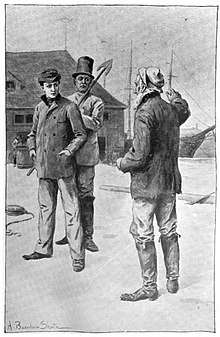Pequod (Moby-Dick)
Pequod is a fictional 19th-century Nantucket whaling ship that appears in the 1851 novel Moby-Dick by American author Herman Melville. Pequod and her crew, commanded by Captain Ahab, are central to the story, which, after the initial chapters, takes place almost entirely aboard the ship during a three-year whaling expedition in the Atlantic, Indian and South Pacific oceans. Most of the characters in the novel are part of Pequod's crew, including the narrator Ishmael.
| Pequod | |
|---|---|
| Moby-Dick vehicle | |
 A stranger points out the Pequod to Ishmael and Queequeg | |
| Captain | Captain Ahab |
| General characteristics | |
| Type | Whaling ship |
Ishmael encounters the ship after he arrives in Nantucket and learns of three ships that are about to leave on three-year cruises. Tasked by his new friend, the Polynesian harpooner Queequeg (or more precisely, Queequeg's idol-god, Yojo), to make the selection for them both, Ishmael, a self-described "green hand at whaling," goes to the Straight Wharf and chooses the Pequod.
It is revealed that Pequod was named for the Algonquian-speaking Pequot tribe of Native Americans, decimated and scattered in the early 1600s by the Pequot War and by the epidemic that preceded it. The Mashantucket (Western Pequot tribe) and Eastern Pequot tribe still inhabit their reservation in Connecticut.
Description
Pequod has endured the years and the elements, but not without sustaining damage. The ship has a quarterdeck and a forecastle and is three-masted like most Nantucket whalers of the time, but all three masts are replacements, taken on when the originals were lost in a typhoon off Japan.[1]
Pequod is not unlike Ahab in this respect, since many of the rest of these missing elements have been replaced by the bones of the whales she hunts. She is not a new vessel, and with age would usually come some veneration and respect, which Ishmael tries to convey by using several historical references in his description of her. But in Pequod's case this has been negated by the thick veneer of barbarity that has been overlaid onto the ship in the form of fantastic scrimshaw embellishment. Far from enjoying mere utilitarian replacements out of available whalebone, she has been ornately decorated, even to the whale teeth set into the railing that now resemble an open jaw. Like a fingerbone necklace on a cannibal, these adornments are clear evidence of Pequod's success as a hunter and killer of whales.
...a rare old craft... She was a ship of the old school, rather small if anything; with an old fashioned claw-footed look about her. Long seasoned and weather-stained in the typhoons and calms of all four oceans, her old hull's complexion was darkened like a French grenadier's, who has alike fought in Egypt and Siberia. Her venerable bows looked bearded. Her masts... stood stiffly up like the spines of the three old kings of Cologne. Her ancient decks were worn and wrinkled, like the pilgrim-worshipped flag-stone in Canterbury Cathedral where Beckett bled. But to all these her old antiquities, were added new and marvellous features, pertaining to the wild business that for more than half a century she had followed...She was apparelled like any barbaric Ethiopian emperor, his neck heavy with pendants of polished ivory. She was a thing of trophies. A cannibal of a craft, tricking herself forth in the chased bones of her enemies. All round, her unpanelled, open bulwarks were garnished like one continuous jaw, with the long sharp teeth of the sperm whale, inserted there for pins, to fasten her old hempen thews and tendons to. Those thews ran not through base blocks of land wood, but deftly travelled over sheaves of sea-ivory. Scorning a turnstile wheel at her reverend helm, she sported there a tiller; and that tiller was in one mass, curiously carved from the long narrow lower jaw of her hereditary foe...A noble craft, but somehow a most melancholy! All noble things are touched with that.
— Moby-Dick, Ch. 16[2]
The principal owners of the vessel are two well-to-do Quaker retired whaling captains, therefore "the other and more inconsiderable and scattered owners, left nearly the whole management of the ship's affairs to these two."
Captain Bildad, who along with Captain Peleg was one of the largest owners of the vessel; the other shares, as is sometimes the case in these ports, being held by a crowd of old annuitants; widows, fatherless children, and chancery wards; each owning about the value of a timber head, or a foot of plank, or a nail or two in the ship. People in Nantucket invest their money in whaling vessels, the same way that you do yours in approved state stocks bringing in good interest..
— Moby-Dick, Ch. 16[2]
Peleg served as first mate under Ahab on Pequod before obtaining his own command, and is responsible for all her whalebone embellishments.
...during the term of his chief-mateship, [he] had built upon her original grotesqueness, and inlaid it, all over, with a quaintness both of material and device, unmatched by anything except it be Thorkill-Hake's carved buckler or bedstead...
— Moby-Dick, Ch. 16[2]
The depiction of life aboard the ship was based on Melville's own experiences in whaling (specifically aboard the Acushnet in the 1840s) and thus can be taken in many ways as representative of mid-19th-century Nantucket whaling.
References
- Melville, Herman. "Chapter xviii — His Mark". Moby-Dick. Retrieved 2008-10-19 – via Princeton.edu.
- Melville, Herman. "Chapter xvi — The Ship". Moby-Dick. Retrieved 2008-10-19 – via Princeton.edu.